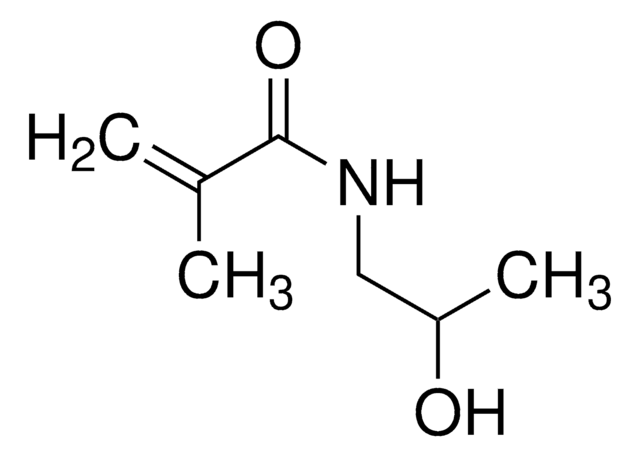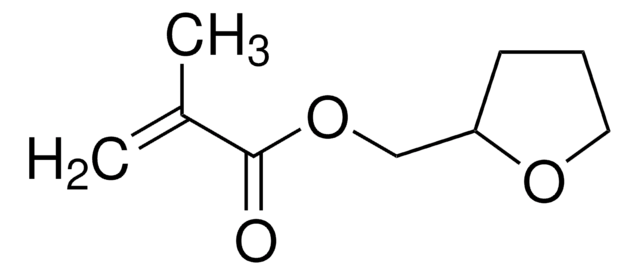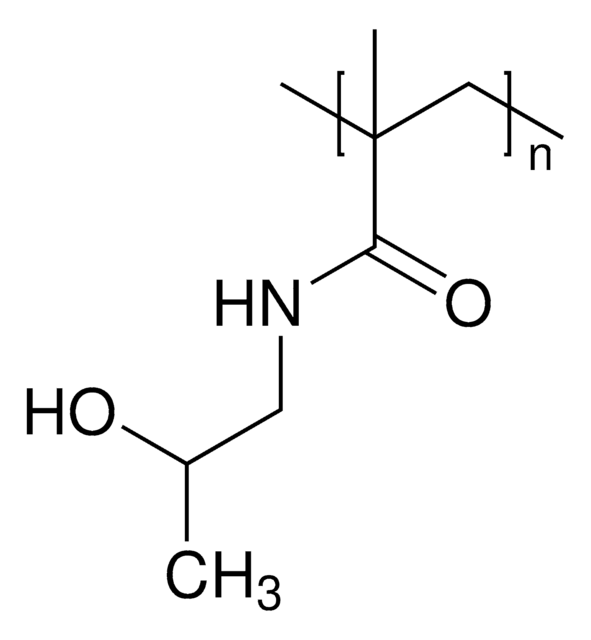268542
Hydroxypropyl methacrylate
Mixture of hydroxypropyl and hydroxyisopropyl methacrylates, 97%, contains 180-220 ppm monomethyl ether hydroquinone as inhibitor
Sinonimo/i:
HPMA
About This Item
Prodotti consigliati
Densità del vapore
>1 (vs air)
Livello qualitativo
Tensione di vapore
0.05 mmHg ( 20 °C)
Saggio
97%
Forma fisica
liquid
contiene
180-220 ppm monomethyl ether hydroquinone as inhibitor
Indice di rifrazione
n20/D 1.447 (lit.)
P. eboll.
57 °C/0.5 mmHg (lit.)
Densità
1.066 g/mL at 25 °C (lit.)
Temperatura di conservazione
2-8°C
Stringa SMILE
CC(=C)C(=O)OCCCO
InChI
1S/C7H12O3/c1-5(2)7(9)10-6(3)4-8/h6,8H,1,4H2,2-3H3
ZMARGGQEAJXRFP-UHFFFAOYSA-N
Cerchi prodotti simili? Visita Guida al confronto tra prodotti
Applicazioni
- Synthesis of poly hydroxypropyl methacrylate cryogel incorporated with Zn/Ce substituted hydroxyapatite nanoparticles for rejuvenation of femoral fracture: This study explores the synthesis of a cryogel incorporating hydroxypropyl methacrylate and Zn/Ce substituted hydroxyapatite nanoparticles, aimed at bone fracture healing (H Zhou, H Jiao, J Xu, Y Liu, S Wei, 2019).
- Poly(Hydroxypropyl methacrylate-co-glycidyl methacrylate): Facile synthesis of well-defined hydrophobic gels containing hydroxy-functional methacrylates: This article presents the synthesis of hydrophobic gels using hydroxypropyl methacrylate and glycidyl methacrylate, useful in various material applications (N Orakdogen, B Sanay, 2017).
- Initiated chemical vapor deposition of poly(Hydroxypropyl methacrylate) thin films: The study covers the chemical vapor deposition process for creating thin films of poly(hydroxypropyl methacrylate) on membranes, enhancing their functional properties (E Sevgili, M Karaman, 2019).
Avvertenze
Danger
Indicazioni di pericolo
Consigli di prudenza
Classi di pericolo
Carc. 1B - Eye Irrit. 2 - Muta. 1B - Skin Irrit. 2 - Skin Sens. 1 - STOT SE 3
Organi bersaglio
Respiratory system
Codice della classe di stoccaggio
6.1C - Combustible acute toxic Cat.3 / toxic compounds or compounds which causing chronic effects
Classe di pericolosità dell'acqua (WGK)
WGK 3
Punto d’infiammabilità (°F)
203.0 °F - closed cup
Punto d’infiammabilità (°C)
95 °C - closed cup
Scegli una delle versioni più recenti:
Possiedi già questo prodotto?
I documenti relativi ai prodotti acquistati recentemente sono disponibili nell’Archivio dei documenti.
I clienti hanno visto anche
Il team dei nostri ricercatori vanta grande esperienza in tutte le aree della ricerca quali Life Science, scienza dei materiali, sintesi chimica, cromatografia, discipline analitiche, ecc..
Contatta l'Assistenza Tecnica.











